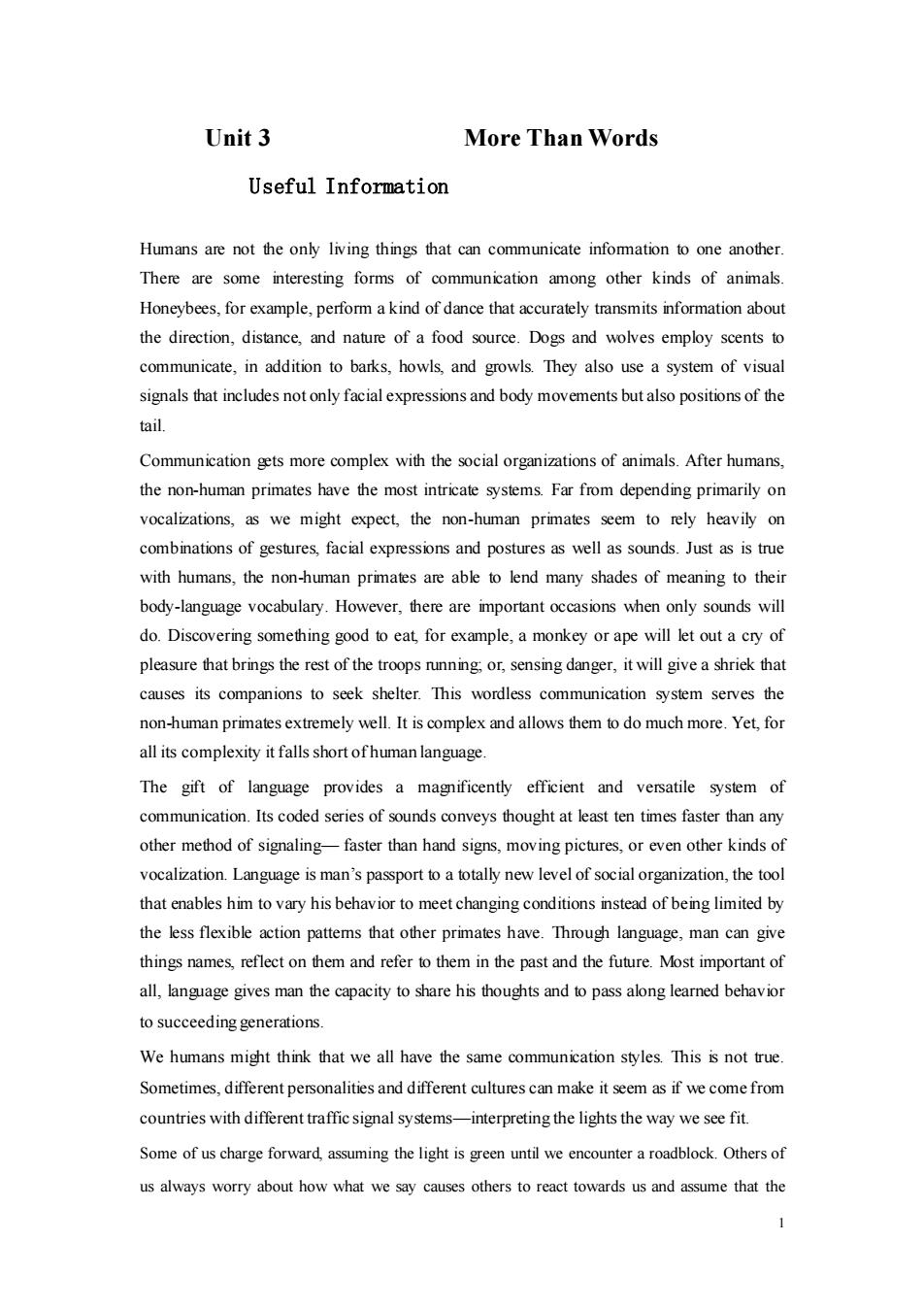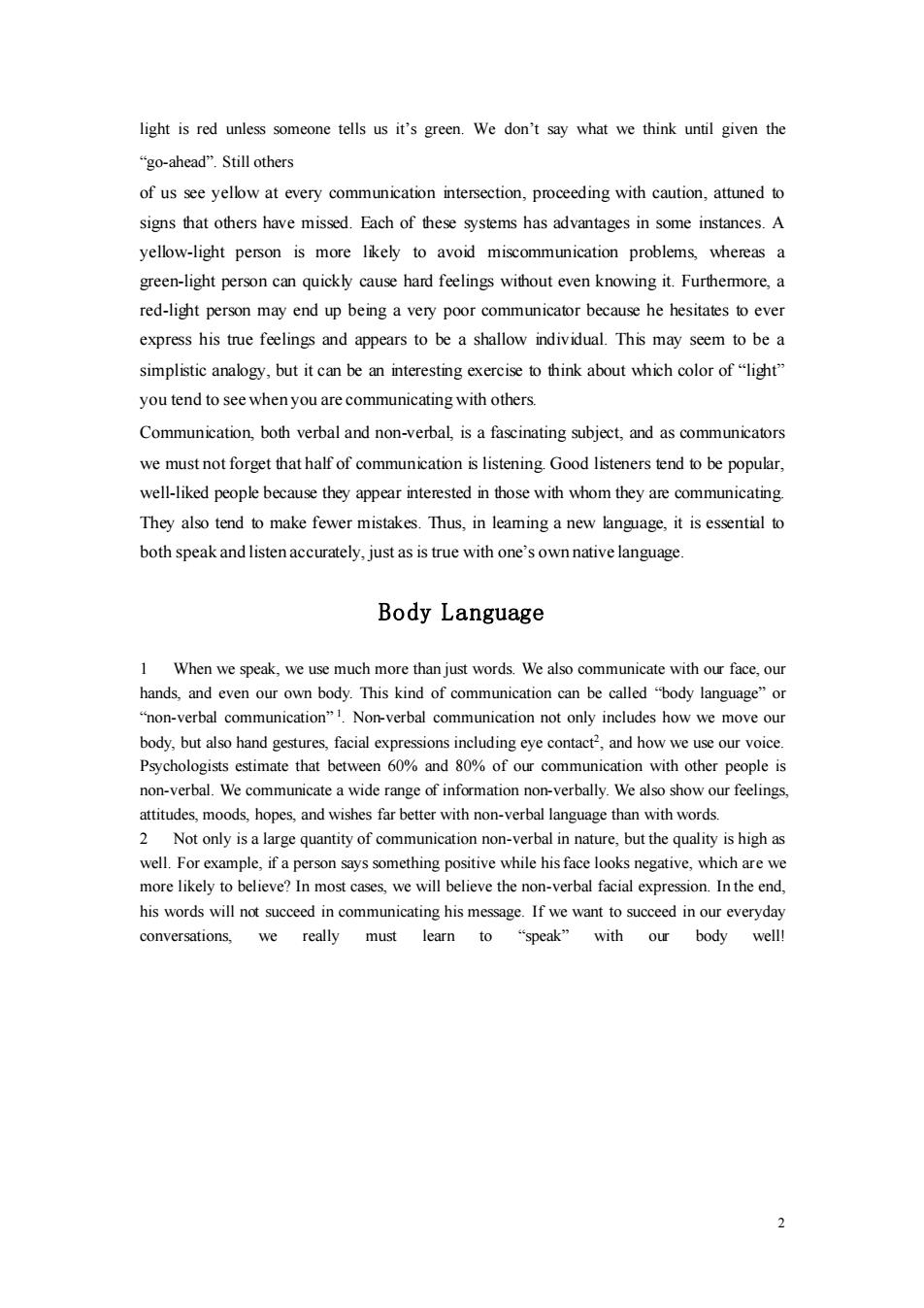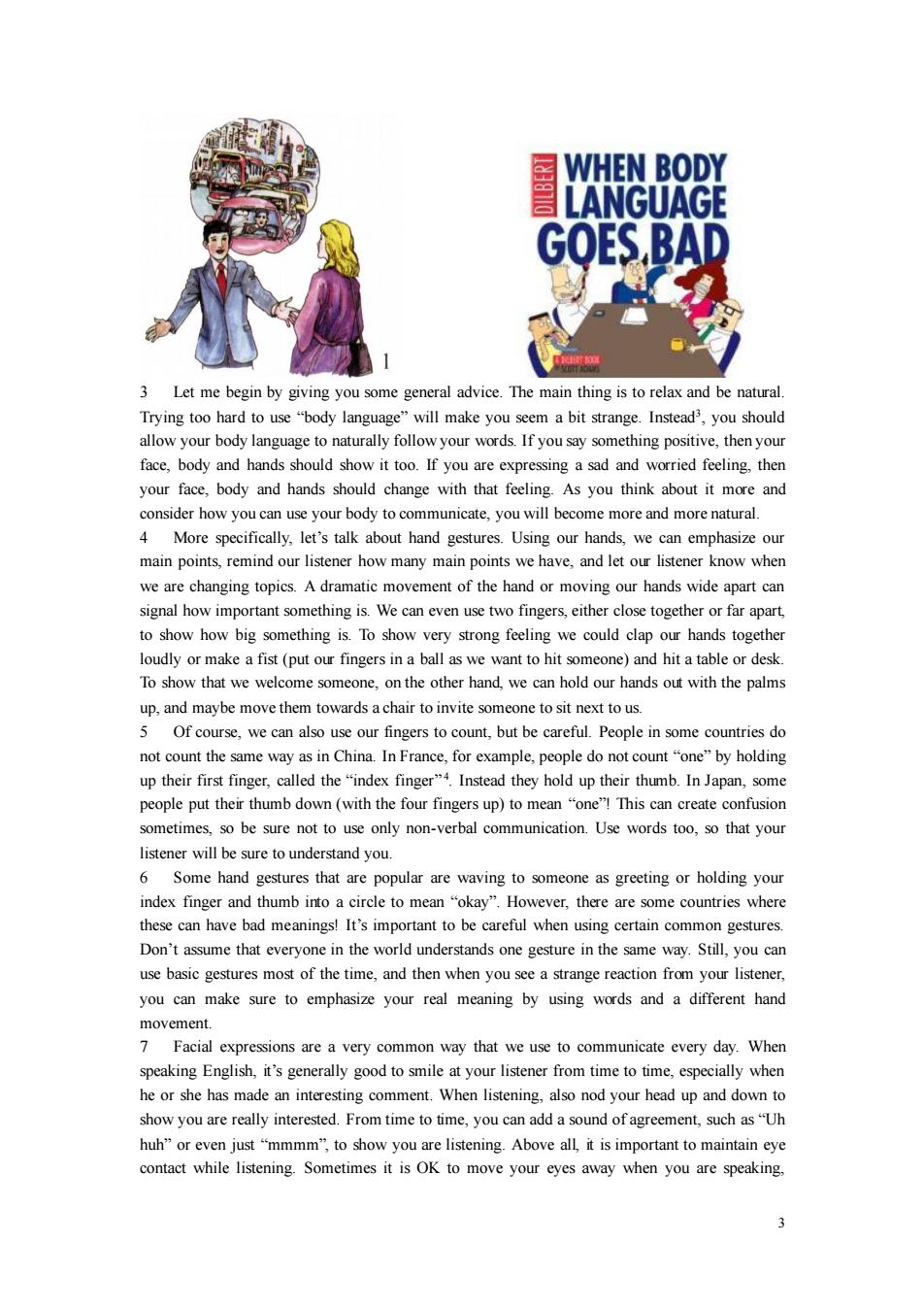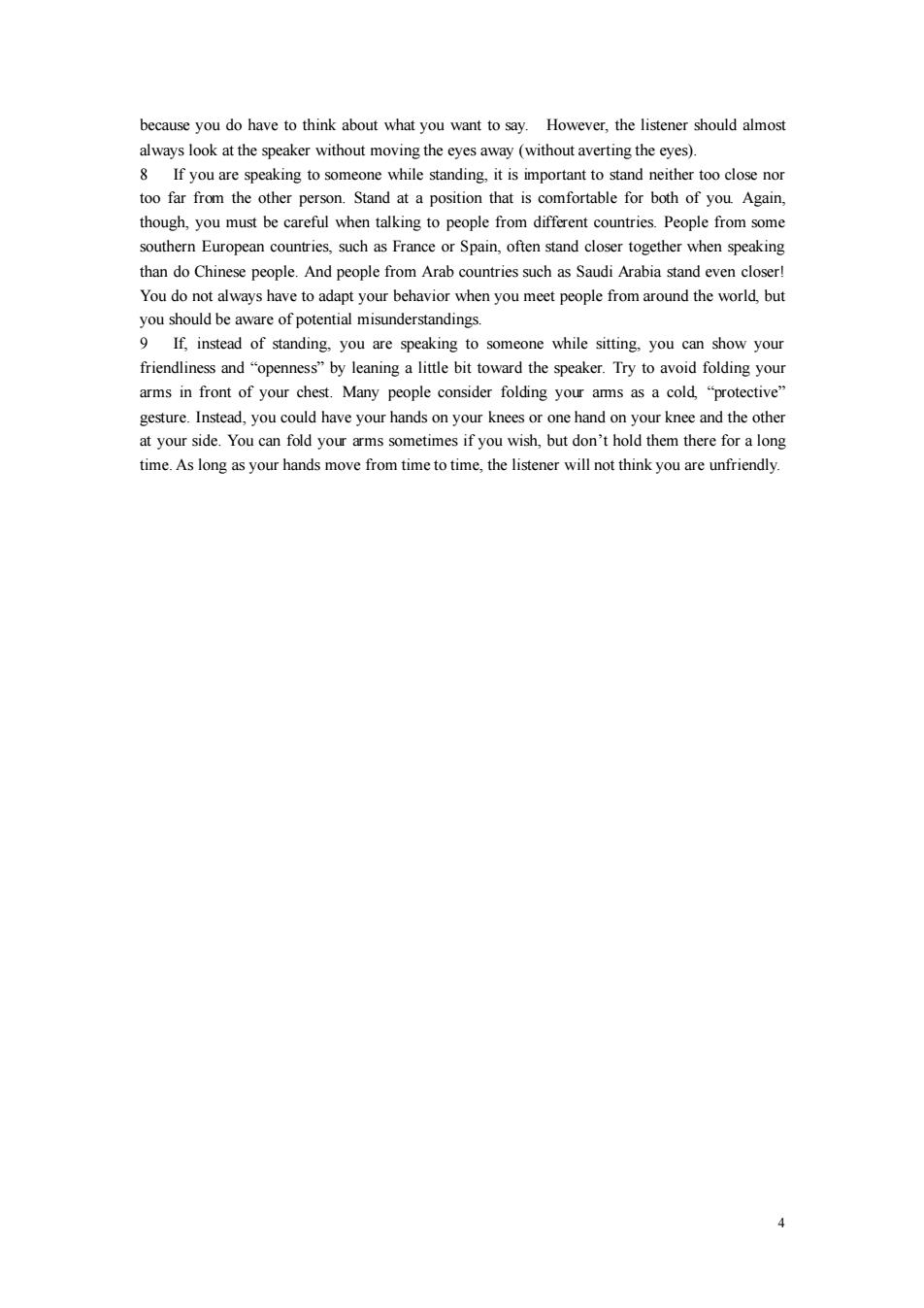
Unit 3 More Than Words Useful Information Humans are not the only living things that can communicate infommation to one another. There are some interesting forms of communication among other kinds of animals. Honeybees,for example,perform a kind of dance that accurately transmits information about the direction,distance,and nature of a food source.Dogs and wolves employ scents to communicate,in addition to barks,howls,and growls.They also use a system of visual signals that includes not only facial expressions and body movements but also positions of the tail. Communication gets more complex with the social organizations of animals.After humans, the non-human primates have the most intricate systems.Far from depending primarily on vocalizations,as we might expect,the non-human primates seem to rely heavily on combinations of gestures,facial expressions and postures as well as sounds.Just as is true with humans,the non-human primates are able to lend many shades of meaning to their body-language vocabulary.However,there are important occasions when only sounds will do.Discovering something good to eat,for example,a monkey or ape will let out a cry of pleasure that brings the rest of the troops running,or,sensing danger,it will give a shriek that causes its companions to seek shelter.This wordless communication system serves the non-human primates extremely well.It is complex and allows them to do much more.Yet,for all its complexity it falls short ofhuman language. The gift of language provides a magnificently efficient and versatile system of communication.Its coded series of sounds conveys thought at least ten times faster than any other method of signaling-faster than hand signs,moving pictures,or even other kinds of vocalization.Language is man's passport to a totally new level of social organization,the tool that enables him to vary his behavior to meet changing conditions instead of being limited by the less flexible action pattems that other primates have.Through language,man can give things names,reflect on them and refer to them in the past and the future.Most important of all,language gives man the capacity to share his thoughts and to pass along learned behavior to succeeding generations. We humans might think that we all have the same communication styles.This is not true. Sometimes,different personalities and different cultures can make it seem as if we come from countries with different traffic signal systems-interpreting the lights the way we see fit. Some of us charge forward,assuming the light is green until we encounter a roadblock.Others of us always worry about how what we say causes others to react towards us and assume that the
1 Unit 3 More Than Words Useful Information Humans are not the only living things that can communicate information to one another. There are some interesting forms of communication among other kinds of animals. Honeybees, for example, perform a kind of dance that accurately transmits information about the direction, distance, and nature of a food source. Dogs and wolves employ scents to communicate, in addition to barks, howls, and growls. They also use a system of visual signals that includes not only facial expressions and body movements but also positions of the tail. Communication gets more complex with the social organizations of animals. After humans, the non-human primates have the most intricate systems. Far from depending primarily on vocalizations, as we might expect, the non-human primates seem to rely heavily on combinations of gestures, facial expressions and postures as well as sounds. Just as is true with humans, the non-human primates are able to lend many shades of meaning to their body-language vocabulary. However, there are important occasions when only sounds will do. Discovering something good to eat, for example, a monkey or ape will let out a cry of pleasure that brings the rest of the troops running; or, sensing danger, it will give a shriek that causes its companions to seek shelter. This wordless communication system serves the non-human primates extremely well. It is complex and allows them to do much more. Yet, for all its complexity it falls short of human language. The gift of language provides a magnificently efficient and versatile system of communication. Its coded series of sounds conveys thought at least ten times faster than any other method of signaling— faster than hand signs, moving pictures, or even other kinds of vocalization. Language is man’s passport to a totally new level of social organization, the tool that enables him to vary his behavior to meet changing conditions instead of being limited by the less flexible action patterns that other primates have. Through language, man can give things names, reflect on them and refer to them in the past and the future. Most important of all, language gives man the capacity to share his thoughts and to pass along learned behavior to succeeding generations. We humans might think that we all have the same communication styles. This is not true. Sometimes, different personalities and different cultures can make it seem as if we come from countries with different traffic signal systems—interpreting the lights the way we see fit. Some of us charge forward, assuming the light is green until we encounter a roadblock. Others of us always worry about how what we say causes others to react towards us and assume that the

light is red unless someone tells us it's green.We don't say what we think until given the "go-ahead".Still others of us see yellow at every communication intersection,proceeding with caution,attuned to signs that others have missed.Each of these systems has advantages in some instances.A yellow-light person is more likely to avoid miscommunication problems,whereas a green-light person can quickly cause hard feelings without even knowing it.Furthermore,a red-light person may end up being a very poor communicator because he hesitates to ever express his true feelings and appears to be a shallow individual.This may seem to be a simplistic analogy,but it can be an interesting exercise to think about which color of"light" you tend to see when you are communicating with others. Communication,both verbal and non-verbal,is a fascinating subject,and as communicators we must not forget that half of communication is listening.Good listeners tend to be popular, well-liked people because they appear interested in those with whom they are communicating. They also tend to make fewer mistakes.Thus,in leaming a new language,it is essential to both speak and listen accurately,just as is true with one's own native language. Body Language 1 When we speak,we use much more than just words.We also communicate with our face,our hands,and even our own body.This kind of communication can be called "body language"or "non-verbal communication".Non-verbal communication not only includes how we move our body,but also hand gestures,facial expressions including eye contact2,and how we use our voice. Psychologists estimate that between 60%and 80%of our communication with other people is non-verbal.We communicate a wide range of information non-verbally.We also show our feelings, attitudes,moods,hopes,and wishes far better with non-verbal language than with words. 2 Not only is a large quantity of communication non-verbal in nature,but the quality is high as well.For example,if a person says something positive while his face looks negative,which are we more likely to believe?In most cases,we will believe the non-verbal facial expression.In the end, his words will not succeed in communicating his message.If we want to succeed in our everyday conversations,we really must learn to "speak"with our body well! 2
2 light is red unless someone tells us it’s green. We don’t say what we think until given the “go-ahead”. Still others of us see yellow at every communication intersection, proceeding with caution, attuned to signs that others have missed. Each of these systems has advantages in some instances. A yellow-light person is more likely to avoid miscommunication problems, whereas a green-light person can quickly cause hard feelings without even knowing it. Furthermore, a red-light person may end up being a very poor communicator because he hesitates to ever express his true feelings and appears to be a shallow individual. This may seem to be a simplistic analogy, but it can be an interesting exercise to think about which color of “light” you tend to see when you are communicating with others. Communication, both verbal and non-verbal, is a fascinating subject, and as communicators we must not forget that half of communication is listening. Good listeners tend to be popular, well-liked people because they appear interested in those with whom they are communicating. They also tend to make fewer mistakes. Thus, in learning a new language, it is essential to both speak and listen accurately, just as is true with one’s own native language. Body Language 1 When we speak, we use much more than just words. We also communicate with our face, our hands, and even our own body. This kind of communication can be called “body language” or “non-verbal communication” 1 . Non-verbal communication not only includes how we move our body, but also hand gestures, facial expressions including eye contact 2 , and how we use our voice. Psychologists estimate that between 60% and 80% of our communication with other people is non-verbal. We communicate a wide range of information non-verbally. We also show our feelings, attitudes, moods, hopes, and wishes far better with non-verbal language than with words. 2 Not only is a large quantity of communication non-verbal in nature, but the quality is high as well. For example, if a person says something positive while his face looks negative, which are we more likely to believe? In most cases, we will believe the non-verbal facial expression. In the end, his words will not succeed in communicating his message. If we want to succeed in our everyday conversations, we really must learn to “speak” with our body well!

WHEN BODY LANGUAGE GOES,BAD 3 Let me begin by giving you some general advice.The main thing is to relax and be natural. Trying too hard to use "body language"will make you seem a bit strange.Instead3,you should allow your body language to naturally follow your words.If you say something positive,then your face,body and hands should show it too.If you are expressing a sad and worried feeling,then your face,body and hands should change with that feeling.As you think about it more and consider how you can use your body to communicate,you will become more and more natural. 4 More specifically,let's talk about hand gestures.Using our hands,we can emphasize our main points,remind our listener how many main points we have,and let our listener know when we are changing topics.A dramatic movement of the hand or moving our hands wide apart can signal how important something is.We can even use two fingers,either close together or far apart, to show how big something is.To show very strong feeling we could clap our hands together loudly or make a fist(put our fingers in a ball as we want to hit someone)and hit a table or desk. To show that we welcome someone,on the other hand,we can hold our hands out with the palms up,and maybe move them towards a chair to invite someone to sit next to us. 5 Of course,we can also use our fingers to count,but be careful.People in some countries do not count the same way as in China.In France,for example,people do not count"one"by holding up their first finger,called the"index finger"4.Instead they hold up their thumb.In Japan,some people put their thumb down(with the four fingers up)to mean "one"!This can create confusion sometimes,so be sure not to use only non-verbal communication.Use words too,so that your listener will be sure to understand you. 6 Some hand gestures that are popular are waving to someone as greeting or holding your index finger and thumb into a circle to mean "okay".However,there are some countries where these can have bad meanings!It's important to be careful when using certain common gestures. Don't assume that everyone in the world understands one gesture in the same way.Still,you can use basic gestures most of the time,and then when you see a strange reaction from your listener, you can make sure to emphasize your real meaning by using words and a different hand movement. 7 Facial expressions are a very common way that we use to communicate every day.When speaking English,it's generally good to smile at your listener from time to time,especially when he or she has made an interesting comment.When listening,also nod your head up and down to show you are really interested.From time to time,you can add a sound of agreement,such as"Uh huh"or even just "mmmm",to show you are listening.Above all,it is important to maintain eye contact while listening.Sometimes it is OK to move your eyes away when you are speaking, 3
3 3 Let me begin by giving you some general advice. The main thing is to relax and be natural. Trying too hard to use “body language” will make you seem a bit strange. Instead3 , you should allow your body language to naturally follow your words. If you say something positive, then your face, body and hands should show it too. If you are expressing a sad and worried feeling, then your face, body and hands should change with that feeling. As you think about it more and consider how you can use your body to communicate, you will become more and more natural. 4 More specifically, let’s talk about hand gestures. Using our hands, we can emphasize our main points, remind our listener how many main points we have, and let our listener know when we are changing topics. A dramatic movement of the hand or moving our hands wide apart can signal how important something is. We can even use two fingers, either close together or far apart, to show how big something is. To show very strong feeling we could clap our hands together loudly or make a fist (put our fingers in a ball as we want to hit someone) and hit a table or desk. To show that we welcome someone, on the other hand, we can hold our hands out with the palms up, and maybe move them towards a chair to invite someone to sit next to us. 5 Of course, we can also use our fingers to count, but be careful. People in some countries do not count the same way as in China. In France, for example, people do not count “one” by holding up their first finger, called the “index finger” 4 . Instead they hold up their thumb. In Japan, some people put their thumb down (with the four fingers up) to mean “one”! This can create confusion sometimes, so be sure not to use only non-verbal communication. Use words too, so that your listener will be sure to understand you. 6 Some hand gestures that are popular are waving to someone as greeting or holding your index finger and thumb into a circle to mean “okay”. However, there are some countries where these can have bad meanings! It’s important to be careful when using certain common gestures. Don’t assume that everyone in the world understands one gesture in the same way. Still, you can use basic gestures most of the time, and then when you see a strange reaction from your listener, you can make sure to emphasize your real meaning by using words and a different hand movement. 7 Facial expressions are a very common way that we use to communicate every day. When speaking English, it’s generally good to smile at your listener from time to time, especially when he or she has made an interesting comment. When listening, also nod your head up and down to show you are really interested. From time to time, you can add a sound of agreement, such as “Uh huh” or even just “mmmm”, to show you are listening. Above all, it is important to maintain eye contact while listening. Sometimes it is OK to move your eyes away when you are speaking

because you do have to think about what you want to say.However,the listener should almost always look at the speaker without moving the eyes away (without averting the eyes). If you are speaking to someone while standing,it is important to stand neither too close nor too far from the other person.Stand at a position that is comfortable for both of you.Again, though,you must be careful when talking to people from different countries.People from some southern European countries,such as France or Spain,often stand closer together when speaking than do Chinese people.And people from Arab countries such as Saudi Arabia stand even closer! You do not always have to adapt your behavior when you meet people from around the world,but you should be aware of potential misunderstandings. 9 If,instead of standing,you are speaking to someone while sitting,you can show your friendliness and "openness"by leaning a little bit toward the speaker.Try to avoid folding your arms in front of your chest.Many people consider folding your amms as a cold,"protective" gesture.Instead,you could have your hands on your knees or one hand on your knee and the other at your side.You can fold your arms sometimes if you wish,but don't hold them there for a long time.As long as your hands move from time to time,the listener will not think you are unfriendly. 4
4 because you do have to think about what you want to say. However, the listener should almost always look at the speaker without moving the eyes away (without averting the eyes). 8 If you are speaking to someone while standing, it is important to stand neither too close nor too far from the other person. Stand at a position that is comfortable for both of you. Again, though, you must be careful when talking to people from different countries. People from some southern European countries, such as France or Spain, often stand closer together when speaking than do Chinese people. And people from Arab countries such as Saudi Arabia stand even closer! You do not always have to adapt your behavior when you meet people from around the world, but you should be aware of potential misunderstandings. 9 If, instead of standing, you are speaking to someone while sitting, you can show your friendliness and “openness” by leaning a little bit toward the speaker. Try to avoid folding your arms in front of your chest. Many people consider folding your arms as a cold, “protective” gesture. Instead, you could have your hands on your knees or one hand on your knee and the other at your side. You can fold your arms sometimes if you wish, but don’t hold them there for a long time. As long as your hands move from time to time, the listener will not think you are unfriendly